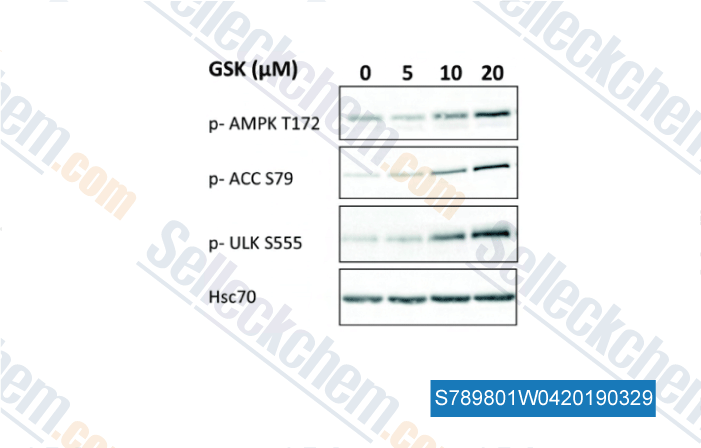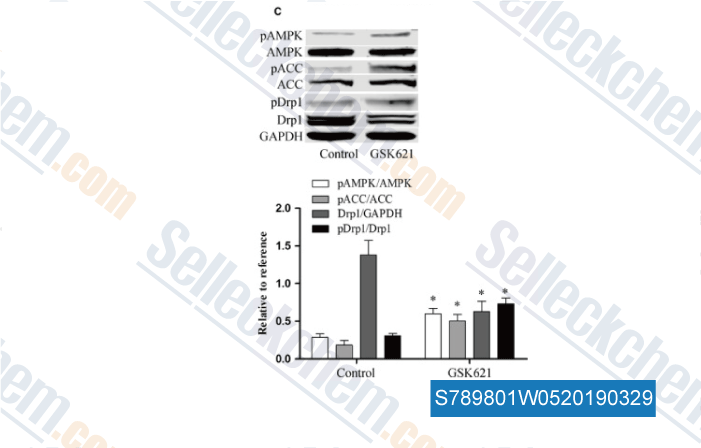|
Toll Free: (877) 796-6397 -- USA and Canada only -- |
Fax: +1-832-582-8590 Orders: +1-832-582-8158 |
Tech Support: +1-832-582-8158 Ext:3 Please provide your Order Number in the email. |
Technical Data
| Formula | C26H20ClN3O5 |
|||
| Molecular Weight | 489.91 | CAS No. | 1346607-05-3 | |
| Solubility (25°C)* | In vitro | DMSO | 100 mg/mL (204.11 mM) | |
| Water | Insoluble | |||
| Ethanol | Insoluble | |||
|
* <1 mg/ml means slightly soluble or insoluble. * Please note that Selleck tests the solubility of all compounds in-house, and the actual solubility may differ slightly from published values. This is normal and is due to slight batch-to-batch variations. * Room temperature shipping (Stability testing shows this product can be shipped without any cooling measures.) |
||||
Preparing Stock Solutions
Biological Activity
| Description | GSK621 is a specific and potent AMPK activator. | |
|---|---|---|
| Targets |
|
|
| In vitro | In AML cell lines and primary AML samples, GSK621 markedly increases phosphorylation at AMPKα T172, a marker of AMPK activation. In a set of 20 cell lines, GSK621 reduces the proliferation of all 20 lines with IC50 ranged from 13-30 μM, and increases apoptosis in 17 (85%) lines. In addition, GSK621 also triggers autophagy, which partially contributes to AML cell death. [1] | |
| In vivo | In nude mice bearing MOLM-14 xenografts, GSK621 (30 mg/kg, i.p.) reduces leukemia growth and significantly extends survival by enhancing AMPK activity and the induction of apoptosis. [1] |
Protocol (from reference)
| Kinase Assay: |
|
|---|---|
| Cell Assay: |
|
| Animal Study: |
|
Customer Product Validation

-
Data from [Data independently produced by , , Haematologica, 2018, doi:10.3324/haematol.2018.191403]

-
Data from [Data independently produced by , , J Cell Mol Med, 2018, doi:10.1111/jcmm.13975]

-
Data from [Data independently produced by , , PLoS One, 2016, 11(8):e0161017.]
Selleck's GSK621 has been cited by 14 publications
| Redefining the role of AMPK in autophagy and the energy stress response [ Nat Commun, 2023, 14(1):2994] | PubMed: 37225695 |
| AMPK Stimulation Inhibits YAP/TAZ Signaling to Ameliorate Hepatic Fibrosis [ Research Square, 2023, 10.21203/rs.3.rs-3727864/v1] | PubMed: none |
| AMPK-PERK axis represses oxidative metabolism and enhances apoptotic priming of mitochondria in acute myeloid leukemia [ Cell Rep, 2022, 38(1):110197] | PubMed: 34986346 |
| GPR120 induces regulatory dendritic cells by inhibiting HK2-dependent glycolysis to alleviate fulminant hepatic failure [ Cell Death Dis, 2021, 13(1):1] | PubMed: 34911928 |
| Effects of (Pro)renin Receptor on Diabetic Cardiomyopathy Pathological Processes in Rats via the PRR-AMPK-YAP Pathway [ Front Physiol, 2021, 12:657378] | PubMed: 34122131 |
| GPA peptide inhibits NLRP3 inflammasome activation to ameliorate colitis through AMPK pathway [ Aging (Albany NY), 2020, 12(18):18522-18544] | PubMed: 32950971 |
| Metformin induces lipogenic differentiation in myofibroblasts to reverse lung fibrosis [ Nat Commun, 2019, 10(1-:2987] | PubMed: 31278260 |
| Ubiquinol-cytochrome C reductase core protein II promotes tumorigenesis by facilitating p53 degradation. [ EBioMedicine, 2019, 40:92-105] | PubMed: 30674441 |
| Neuronal AMP-activated protein kinase hyper-activation induces synaptic loss by an autophagy-mediated process [ Cell Death Dis, 2019, 10(3):221] | PubMed: 30833547 |
| The Transcription Factors TFEB and TFE3 Link the FLCN-AMPK Signaling Axis to Innate Immune Response and Pathogen Resistance. [ Cell Rep, 2019, 26(13):3613-3628] | PubMed: 30917316 |
RETURN POLICY
Selleck Chemical’s Unconditional Return Policy ensures a smooth online shopping experience for our customers. If you are in any way unsatisfied with your purchase, you may return any item(s) within 7 days of receiving it. In the event of product quality issues, either protocol related or product related problems, you may return any item(s) within 365 days from the original purchase date. Please follow the instructions below when returning products.
SHIPPING AND STORAGE
Selleck products are transported at room temperature. If you receive the product at room temperature, please rest assured, the Selleck Quality Inspection Department has conducted experiments to verify that the normal temperature placement of one month will not affect the biological activity of powder products. After collecting, please store the product according to the requirements described in the datasheet. Most Selleck products are stable under the recommended conditions.
NOT FOR HUMAN, VETERINARY DIAGNOSTIC OR THERAPEUTIC USE.
